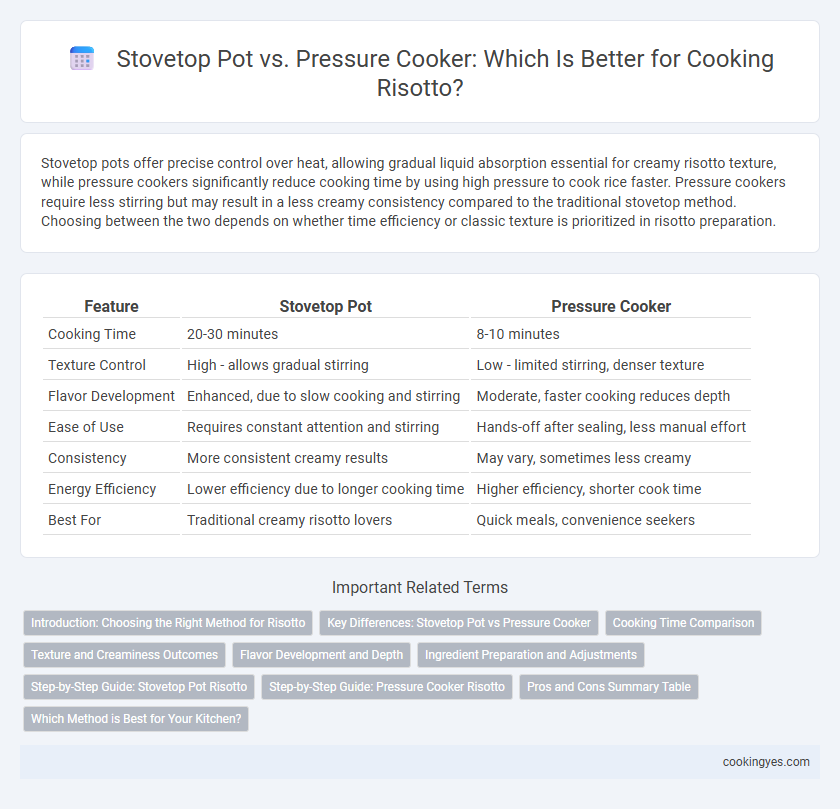Stovetop pots offer precise control over heat, allowing gradual liquid absorption essential for creamy risotto texture, while pressure cookers significantly reduce cooking time by using high pressure to cook rice faster. Pressure cookers require less stirring but may result in a less creamy consistency compared to the traditional stovetop method. Choosing between the two depends on whether time efficiency or classic texture is prioritized in risotto preparation.
Table of Comparison
| Feature | Stovetop Pot | Pressure Cooker |
|---|---|---|
| Cooking Time | 20-30 minutes | 8-10 minutes |
| Texture Control | High - allows gradual stirring | Low - limited stirring, denser texture |
| Flavor Development | Enhanced, due to slow cooking and stirring | Moderate, faster cooking reduces depth |
| Ease of Use | Requires constant attention and stirring | Hands-off after sealing, less manual effort |
| Consistency | More consistent creamy results | May vary, sometimes less creamy |
| Energy Efficiency | Lower efficiency due to longer cooking time | Higher efficiency, shorter cook time |
| Best For | Traditional creamy risotto lovers | Quick meals, convenience seekers |
Introduction: Choosing the Right Method for Risotto
Stovetop pots provide precise control over temperature and stirring, essential for achieving the creamy texture characteristic of traditional risotto. Pressure cookers significantly reduce cooking time by creating a high-pressure environment that accelerates the absorption of broth into Arborio rice. Choosing between these methods depends on balancing the authentic, hands-on experience with efficiency and convenience in risotto preparation.
Key Differences: Stovetop Pot vs Pressure Cooker
Stovetop pots offer precise temperature control essential for the gradual release of starches, creating the creamy texture characteristic of traditional risotto. Pressure cookers reduce cooking time significantly by trapping steam and raising the boiling point, but may compromise the delicate stirring process integral to developing risotto's signature consistency. While stovetop pots require constant attention, pressure cookers deliver a faster, hands-off alternative, suitable for those prioritizing convenience over the classic cooking method.
Cooking Time Comparison
Stovetop pots typically require 18 to 20 minutes to cook risotto, allowing gradual absorption of broth and evenly creamy texture. Pressure cookers significantly reduce cooking time, often completing risotto in 7 to 10 minutes by trapping steam and increasing heat. While pressure cookers are time-efficient, stovetop methods offer more precise control over consistency and risotto creaminess.
Texture and Creaminess Outcomes
Stovetop pots allow gradual liquid absorption, resulting in risotto with a distinct creamy texture and slightly firm, al dente grains. Pressure cookers expedite the cooking process by using high pressure and steam, which can create a softer, less textured risotto with a uniform creaminess but potentially diminished individual grain definition. For achieving traditional risotto texture with optimal creaminess, stovetop cooking remains the preferred method among culinary experts.
Flavor Development and Depth
Stovetop pots allow gradual liquid absorption and consistent stirring, promoting Maillard reactions that enhance risotto's complex flavors and creamy texture. Pressure cookers expedite cooking by trapping steam, which limits evaporation and reduces the development of deep, caramelized notes crucial for traditional risotto. Chefs seeking rich flavor depth typically prefer stovetop methods to maximize aroma and texture through prolonged, controlled heat application.
Ingredient Preparation and Adjustments
Stovetop pots allow gradual absorption of broth, enabling precise control over rice texture and incremental ingredient additions like sauteed onions and wine. Pressure cookers reduce cooking time significantly but require precise liquid measurements and limit timing adjustments, making real-time ingredient layering more challenging. Adjusting seasoning after pressure cooking is often necessary to achieve the desired balance in flavor and consistency.
Step-by-Step Guide: Stovetop Pot Risotto
Stovetop pot risotto offers precise control over heat and texture, allowing gradual stirring to release rice starch for creamy consistency. Begin by sauteing onions and toasting Arborio rice in butter or olive oil, then slowly add warm broth one ladle at a time until absorbed, stirring continuously. This method requires patience but yields rich, deeply flavored risotto with perfectly tender grains compared to faster pressure cooker techniques.
Step-by-Step Guide: Pressure Cooker Risotto
Using a pressure cooker for risotto significantly reduces cooking time by steaming the rice under high pressure, resulting in creamy texture within 7-10 minutes. Begin by sauteing aromatics and rice directly in the pressure cooker, add broth, seal the lid, and cook at high pressure, then quickly release the pressure before stirring in cheese and butter. This method maintains flavor intensity and delivers consistent results, outperforming traditional stovetop pots that require constant stirring and longer cooking times.
Pros and Cons Summary Table
The stovetop pot offers precise temperature control and traditional texture, making it ideal for authentic risotto but requires constant stirring and longer cooking time. The pressure cooker significantly reduces cooking time and energy usage, delivering creamy results with less attention, yet it risks overcooking and less control over texture. A summary table contrasts stovetop pot's manual stirring and gradual flavor development against pressure cooker's speed and convenience balanced by potential texture compromises.
Which Method is Best for Your Kitchen?
Stovetop pots offer precise control over heat, allowing gradual stirring essential for creamy risotto, while pressure cookers significantly reduce cooking time by using high pressure to cook rice quickly and evenly. For home cooks prioritizing traditional texture and flavor development, stovetop methods remain best, whereas busy kitchens benefit from pressure cookers for fast, consistent results without constant attention. Equipment availability, cooking experience, and desired risotto texture ultimately determine the most suitable method for your kitchen.
Stovetop pot vs Pressure cooker for risotto cooking Infographic

 cookingyes.com
cookingyes.com